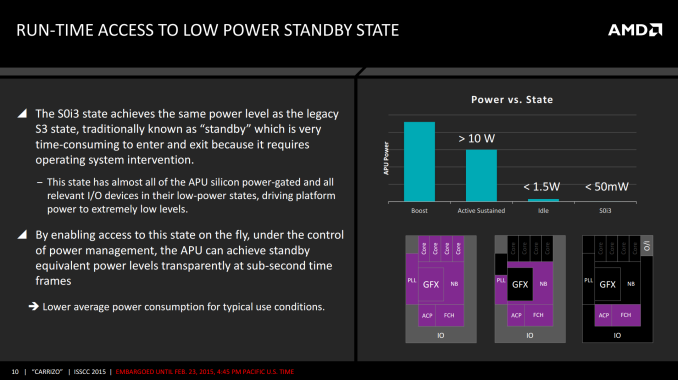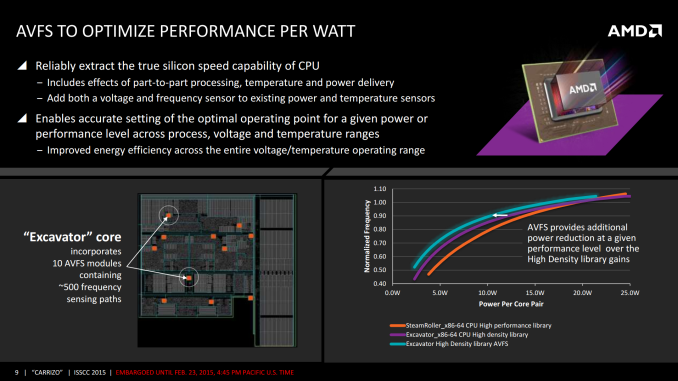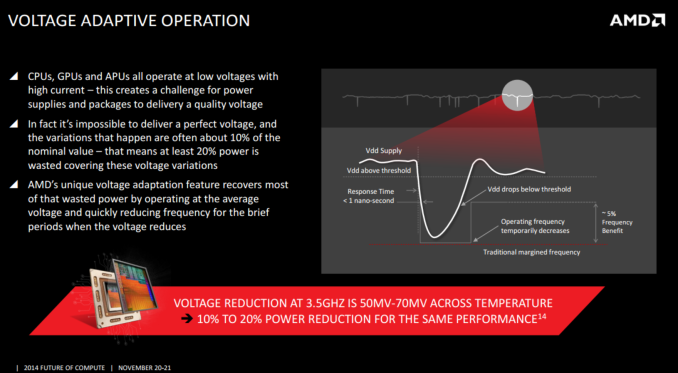AMD Launches Carrizo: The Laptop Leap of Efficiency and Architecture Updates
by Ian Cutress on June 2, 2015 9:00 PM ESTPower Saving and Power Consumption
When it comes to power, Carrizo features two/three technologies worth discussing. The first is the use of low power states, and the different frequency domains within the SoC. Previous designs had relatively few power planes, which left not as many chances for the SoC to power down areas not in use. Carrizo has ten power planes that can be controlled at run-time, allowing for what can be described as a dynamic race to sleep. This is bundled with access to the S0i3 power state, giving sub 50mW SoC power draw when in sleep and wake-up times under a second.
This is also combined with automated voltage/frequency sensors, of which an Excavator core has 10 each. These sensors take into consideration the instructions being processed, the temperature of the SoC, the quality of power delivery as well as the voltage and frequency at that point in order to relay information about how the system should adjust for the optimal power or performance point.
AMD states that this gives them the ability to adjust the frequency/power curve on a per-module basis further again to the right, providing another reduction in power or increase in frequency as required.
Next up for discussion is the voltage adaptive operation that was introduced back in Kaveri. I want to mention it here again because when it was first announced, I thought I understood it at a sufficient level in order to write about it. Well, having crossed another explanation of the feature by David Kanter, the reason for doing so clicked. I’m not going to steal his thunder, but I suggest you read his coverage to find out in more detail, but the concept is this:
When a processor does work, it draws power. The system has to be in a position to provide that power, and the system acts to restabilize the power while the processor is performing work. The work being done will cause the voltage across the processor to drop, to what we classically call Voltage Droop. As long as the droop does not cause the system to go below the minimum voltage required for operation, all is good. Voltage Droop works if the supply of power is consistent, although that cannot always be guaranteed – the CPU manufacturer does not have control over the quality of the motherboard, the power supply or the power conversion at hand. This causes a ripple in the quality of the power, and the CPU has to be able to cope with these ripples as these ripples, combined with a processor doing work, could cause the voltage to drop below the threshold.
The easiest way to cope is to put the voltage of the processor naturally higher, so it can withstand a bigger drop. This doesn’t work well in mobile, as more voltage results in a bigger power draw and a worse experience. There are other potential solutions which Kanter outlines in his piece.
AMD has tackled the problem is to get the processor to respond directly. When the voltage drops below a threshold value, the system will reduce the frequency and the voltage of the processor by around 5%, causing the work being done to slow down and not drain as much. At AMD’s Tech Day, they said this happens in as quickly as 3 cycles from detection, or in under a nanosecond. When the voltage drop is normalized (i.e. the power delivery is a more tolerable level), the frequency is cranked back up and work can continue at a normal rate.
Obviously the level of the threshold and the frequency drop will determine how much time is spent in this lower frequency state. We were told that with the settings used in Carrizo, the CPU hits this state less than 1% of the time, but it accounts for a sizeable chunk of overall average power reduction for a 3.5 GHz processor. This may sound odd, but it can make sense when you consider that the top 5% of the frequency is actually the most costly in terms of power than any other 5%. By removing that 5% extreme power draw, for a minimal performance loss (5% frequency loss for sub 1% of the time), it saves enough power to be worthwhile.













137 Comments
View All Comments
Refuge - Wednesday, June 3, 2015 - link
Built my mother a new system from her old scraps with a new A8, she loves that desktop, and when she put an SSD in it finally she loved it ten times more. the upgrade only cost her $300, for CPU, Mobo, RAM. Threw it together in 45 minutes, and she hasn't had a problem with it in 2 years so far.nathanddrews - Wednesday, June 3, 2015 - link
I prefer the following setup:1. Beast-mode, high-performance desktop for gaming, video editing, etc.
2. Low-power, cheap notebook/tablet for In-Home Steam Streaming and light gaming (720p) on the go.
In my use case, as long as I can load and play the game (20-30fps for RTS, 30fps+ for everything else) on a plane ride or some other scenario without AC access, I'm not really concerned with the AA or texture quality. I still want to get the best experience possible, but balanced against the cheapest possible price. The sub-$300 range is ideal for me.
AS118 - Wednesday, June 3, 2015 - link
Yeah, that's my thing as well. High resolutions at work, and at home, 768p or 900p's just fine, especially for gaming.I also recommend AMD to friends and relatives who want laptops and stuff that can do casual gaming for cheap.
FlushedBubblyJock - Tuesday, June 9, 2015 - link
Why go amd when HD3000 does just fine gaming and the added power of the intel cpu is an awesome boost overall ...Valantar - Wednesday, June 3, 2015 - link
1366*768 on anything larger than 13" looks a mess, but in a cheap laptop I'd rather have a 13*7 IPS for the viewing angles and better visuals than a cheap FHD TN panel - bad viewing angles especially KILL the experience of using a laptop. Still, 13*7 is pretty lousy for anything other than multimedia - it's simply too short to fit a useful amount of text vertically. A decent compromise would be moving up to 1600*900 as the standard resolution on >11" displays. Or, of course, moving to 3:2 or 4:3 displays, which would make the resolution 1366*911 or 1366*1024 and provide ample vertical space. Still, 13*7 TN panels need to go away. Now.yankeeDDL - Wednesday, June 3, 2015 - link
Like I said, to each his own. I have a Lenovo Z50 which I paid less than $470 with the A10 7300.Quite frankly, I could not be happier and I think it provides a massive value for that money.
Sure, a larger battery and a better screen would not hurt, but for hustling it around the house, or bring it to friend/family house, watch movies, play games at native resolution, it is fantastic.
It's no road warrior, for sure (heavy and the battery life doesn't go much beyond 3hrs of "serious" use) but playing at 1366*768 on something that weights 5 pounds and costs noticeably less than $500, is quite amazing. Impossible on an Intel+discrete graphics, as far as I know.
FlushedBubblyJock - Tuesday, June 9, 2015 - link
Nope, HD3000 plays just fineMargalus - Wednesday, June 3, 2015 - link
I'd rather have a cheaper 15.6" 1366x768 TN panel over a more expensive smaller ips panel.UtilityMax - Wednesday, June 3, 2015 - link
1366x768 is fine for movies and games. But it's a bad resolution for reading text or viewing images on the web, since you see pixels the size of moon crater.BrokenCrayons - Thursday, June 4, 2015 - link
I understand there's going to be a variety of differing opinions on the idea of seeing individual pixels. As far as I'm concerned, seeing individual pixels isn't a dreadful or horrific thing. In fact, to me it simply doesn't matter. I'm busy living my meat world life and enjoying whatever moments I have with family and friends so I don't give the ability to discern an individual pixel so much as a second thought. It is an insignificant part of my life, but what isn't is the associated decline in battery life (on relative terms) required to drive additional, utterly unnecessary pixels and to push out sufficient light as a result of the larger multitude of them. That sort of thing is marginally annoying -- then again, I still just don't care that much one way or another aside from noticing that a lot of people are very much infatuated with an insignificant, nonsense problem.